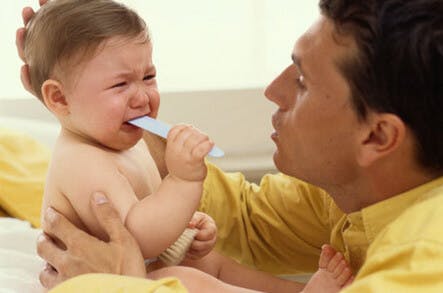Poison Oak, Poison Ivy and Poison Sumac

Question
I am a mother of two. I have a 7 year old and a 6 month old. We just found out today that my son has poison ivy, or oak. My concern is my 6 month old. We have kept him away from her but if she did get it how harmful is it to an infant? And what other things should we do to keep her from getting it?
Shannon Stover - Oklahoma City, Oklahoma
Dr. Greene's Answer
It’s Monday morning. You’ve had a wonderful weekend playing with your kids and your dog, romping through the woods. Now, as you lie in bed, you hear whimpering coming from the next room. A few minutes later, your son comes in to join you in bed, sporting red itchy patches on his arms and legs — he has poison oak (or poison ivy, or poison sumac).
Whichever of these plants he came across while playing, the culprit is the same — an oil called urushiol. This oil is found in the leaves, roots, and twigs of these plants. There is no difference in the rashes, since there is no difference in the cause. (A few other plants contain the same oil in lesser amounts, including the Japanese lacquer tree [and thus some lacquered furniture], the gingko tree, the shells of cashews, the shells of brazil nuts, and the rinds of mangoes — sensitive individuals would do well to avoid all of these).
Wherever the oil touches the skin of a sensitive individual, an exquisitely itchy, red rash will appear between 8 and 72 hours (usually 12-48 hours) later, which will often go on to develop blisters. The first time a person touches this oil, s/he may break out 7 to 10 days later. Most people, however, will have no reaction the first time they are exposed. In fact, children under the age of 7 are rarely sensitive. Sensitivity is particularly rare under the age of one, and when infants do break out, the rash is usually mild. (One of my sons is convinced that he will always be immune, because he’s played in poison oak a few times with no rash — he may be in for a rude awakening this summer, or he may be one of the 15%-30% of individuals who never develop sensitivity).
Again, the oil is the culprit. As soon as you suspect that your child is exposed to urushiol, have him wash thoroughly with lots of warm water and soap (hot water opens the pores, and may transiently increase exposure). Water alone will also work, but not quite as well. If you don’t have water, use rubbing alcohol. Don’t use a washcloth, since this tends to spread the oil to other patches of skin. Likewise, a shower is much preferable to a bath. Have him rinse thoroughly. If the oil is removed within 5-10 minutes, you may prevent, or at least minimize, the rash. Even if he doesn’t wash for a long time, washing is still very important. The oil remains on the skin until it is rubbed or washed off. It can cause a new reaction wherever it touches — thus, after the forearms and lower legs, the most common spot for a poison ivy rash is the male genitalia!
The oil from poison plants can stick to virtually anything. It can dry and remain potent indefinitely. This is why camping trips can produce such horrible cases of poison oak. Anything that your son has touched between his exposure and a thorough shower should be washed in soap and water (preferably hot), hosed down, or soaked in water and alcohol. This includes clothing, shoes, balls, toys, tools, and the towel he used after his shower. After washing the contaminated articles, don’t forget to wash your own hands, and anything those articles touched.
Once the oil has been removed, the rash from poison oak or poison ivy is not contagious. Even the oozing blisters are not contagious, although they look like they should be. Because new blisters can keep appearing over the course of a week, people assume that touching the rash causes it to spread, or that the ooze itself is responsible for the spreading. The fluid that fills the blisters is one’s own serum, not the poisonous oil. The skin only breaks out where it actually comes into contact with the urushiol. The sensitivity of the skin, and the amount of oil, determine the speed of the eruption. Places where the oil is most concentrated, or the skin the most vulnerable, break out first, followed days later by places where there was only a little oil, or the skin is a more effective barrier. Woe to those with eczema!
As long as the oil is no longer present, scratching does not make the rash spread. Scratching does make the already intense itching even more unbearable and can also cause the rash to get infected.
The best way to prevent an outbreak of poison oak is to avoid any contact with the oil in the first place. Teach your children to recognize the poisonous plants of your region. Before an outing where you are concerned about these plants, you might want to coat your child’s skin with a barrier cream. (Hollister Moisture Barrier, Hydropil, IvyBlock and Stoko-Gard Outdoor Cream are all fairly good at protecting the skin from the oil, but must be reapplied hourly to remain effective).
Perhaps in your weekend outing you were exceptionally careful. You and the kids stayed on the path, and you saw no poison oak or ivy — but your dog went chasing after a bird. When he rejoined you, his fur was coated with oil. The oil transferred easily when he rubbed against your son’s clothing, or when you leaned down to pet him. Thus, the last tip for prevention — don’t forget to hose down the dog!


